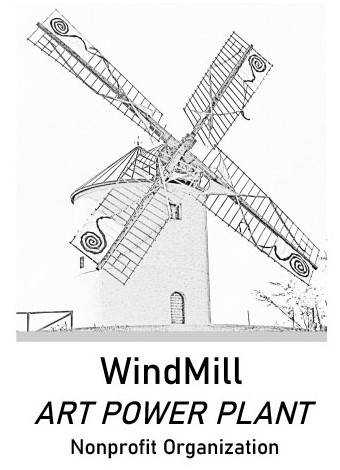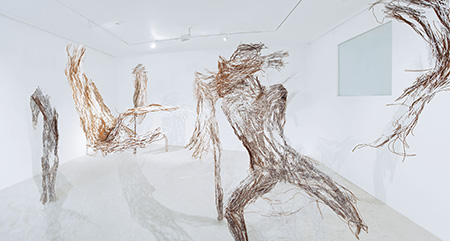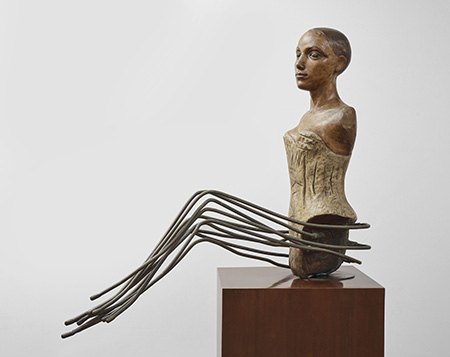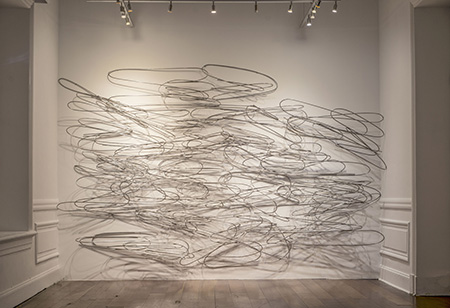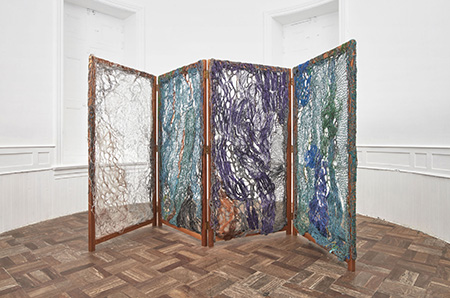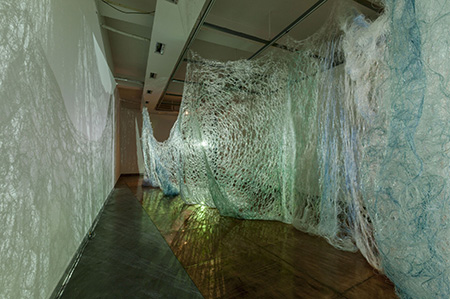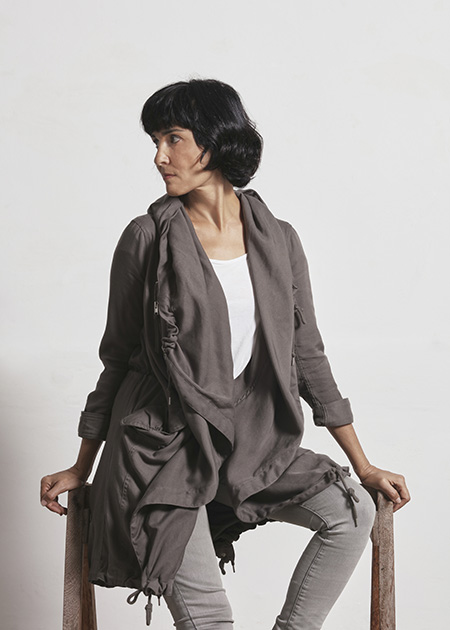
Biography
I was born in Lima, Perú in 1969. In my earliest memories I am balancing on a hammock swing, a sort of external womb from which I observe the world suspended in midair. I spent a lot of time there because I was born premature and that helped adjust my still developing hip. I think this sensory primary experience of ingravity, my first perception of reality, has always lingered within me and found its way out through most of my art.
And then there is my grandmother. She was that magical being capable of opening doors that gave me access to subtler planes of existence. She knitted, created flower arrangements, cooked wonderfully – and everything she did, everything she touched, immediately turned to art. She didn’t study art but she was an artist. Hers was a world where touching textures was important, where the shadows, the movement of the leafs, the rythms of music, the compositions, the colours of nature where the language. Our language. Very connected to poetry and the oral and written language as well, and one that I´ve later used in my work as narratives.
From an early age I realized art was a way I could use express myself, seek answers to questions grown ups didn’t seem to know how to answer for me, say the uncomfortable things I needed to say, assert myself, and sublimate painful experiences. Such is, and has always been, my relationship with art.
At age 16 I found myself standing outside Cristina Gálvez’s workshop. I had decided to study drawing and sculpture with artist Margarita Checa. It was the first time I came across shapes, lights and perspectives as much needed elements to consider when drawing. I became fascinated by the human body, trying to draw it in such a way that you could somehow perceive the humanity, the essence, behind each person. Cristina Gálvez had already died by that time, but her aura lingered in the house – and her work’s fascinating way to approach the emptiness or void has permeated my own art in more ways than I could say.
Great teachers continued to pave my way at Pontificia Universidad Católica del Perú’s Art Faculty. Anna Maccagno, with her mantra sculpt as you would pet a cat or sculpt just how the river hits the stone until it`s round, taught me to follow nature´s way of changing landscapes with patience, to understand the materials and how I should move in order to shape them properly, like a dance between body and matter.
Another mentor, Adolfo Winternitz showed me the beauty of letting light and colour pass through objects. So even though up until 2003 my work was mainly solid – wood carvings, bronze castings, portraits made with bee wax, and resin/fiberglass sculptures – I was always captivated with looking through the materials and working in layers: finding textures, glazes, cracks, like layers of skin, like a vintage palimpsest where you get a glimpse of something hidden, like a transparent and bright glass found by a child, eyes-wide-open amazed.
In 2004 I continued experimenting with different means and techniques, but always connected to drawing, which has always been key to understanding my work. A drawn line talks, carries meaning – the dense lines of weight and the lines of the levity of light. I use wire as if it were ink, and leave empty spaces to observe the shadows. Sometimes the stainless steel seems to be smoke or clouds and the nylon becomes sea foam. And so begin to appear textiles and aerial drawings in my art.
With this techniques I exhibited art instalations and sculptures at the Wire tradefair in 2006, 2008, 2010 (Messe Düsseldorf, Germany). The art instalation Chromotherapy (2008) was then exhibited in Berlin, Vienna and Sao Paulo.
“It is not fortuitous that the web is the image that best defines the progress of sculptor Nani Cárdenas’ visual vocabulary: the web as strategy and road map, but also as metaphor. From the initial investigations in the interstices of meaning in wood carvings to the delicate and complex spatial drawings in Chromotherapy, this is an oeuvre with an incresing density of symbolism that has conquererd domains of experience and representation. These domains interweave, intersect and communicate, and it is in this movement that they find their relevance.
With the coordinates proposed by Cárdenas’ work, weaving has ceased to be functional, generic and anchored in the cliché of the femenine to become a representation of drawing in space: pure colours, free strokes, knots and denouments. Each of the pieces in Chromotherapy acts rhythmically, gaining volumn and then narrowing down until it becomes a surface, an offering itself as an outline of a human, animal or plant figure before returning to being a flowing line, the purity of form.” (Diego Otero, 2008)
While participating in Wire, and later on while experimenting with P.E.T felt for the exhibitions El anverso de las nubes alongside artist Kyle Huffman, as well as Ser P.E.T in collaboration with Edi Hirose, I fully integrated into my way of working doing so in alliance with other people and/or industries, realizing that sometimes at non-conventional scenarios a lot of uncharted opportunities can arise. I realized industry and art could work very well together, and that objects and materials don’t necessarily have to respond to the purpose they were created for. I’ve always been drawn to materials that have been or could be transformed from something thrown away or abandoned into the possibility of a second life.
The importance of collaboration has always been evident in the way I work. I created the multi-disciplinary group project [del cuarto cuerpo] (2011, 2012), co- created the exhibition Mitad Ceniza Mitad Latido, a dialogue alongside Elisenda Estrems established with the poetry of Jorge Eielson (2018), and Aniquilar la luz o hacerla, where 18 artists dialogued with the poetry of Blanca Varela (2022).
Throughout my art there’s an exploration that poses questions around identity: the self, the unique nature of another being, the other as mirror of the self, the space we occupy, bodies as territories, memory. There’s in this looking at another person a realization of the common fate of being human that shows how we’re all interconnected.
Curriculum
Studied drawing and sculpture in Cristina Gálvez’s workshop during 1986 and 1987.
Graduated valedictorian from Pontificia Universidad Católica del Perú’s Art Faculty in 1993, where she earned the award for best sculpture.
Nani Cárdenas draws by weaving and weaves by drawing, always reflecting upon the awareness of the void, which is the principle of her sculpture. Her work revolves around the notions of body and territory.
She is cultural manager of projects in collaboration with other artists. She is a member of Colectivo Andamio (www.andamio.org.pe).
The exhibition Mitad Ceniza Mitad Latido, Nani Cárdenas + Elisenda Estrems, received from El Comercio, Perú: the Luces Award to Best Exhibition 2020.
She has made sculptures for Lima’s public spaces, highlighting the life-size portrait of Ricardo Palma at Tradiciones park as well as the sculpture of writer Antonio Cisneros in the Cisneros boardwalk, both made by casting bronze.
She has recently participated in: Aniquilar la luz o hacerla, lectura plástica en torno al a poética de Blanca
Varela, Fundacion BBVA Gallery (Arequipa, 2022);
The itinerant exhibition Mitad Ceniza Mitad Latido, Nani Cárdenas + Elisenda Estrems, un diálogo plástico en torno a la poética de Jorge Eielson has been presented at: Sala 1 galleria, Chiasso Perduto galleria, the Corridoio Fiorentino, and Peruvian Consulate’s Gallery (Rome, Florence, Milan, 2022). Fundacion BBVA’s Gallery (Arequipa, 2019 – 2020). Centro Cultural Inca Garcilaso (Lima, 2019).
Mexican Consulate´s Gallery (San Francisco, CA, 2018);
Formas de habitar, Nani Cárdenas + Micaela Aljovín, Galería Forum (Lima, 2021);
Hay algo incomestible en la garganta, Sala German Kruger Espantoso ICPNA (Lima, 2021);
De Voz a Voz Perú, Museo de Arte Contemporáneo de Lima (Lima, 2021);
Jorge Eielson: Arte come nodo, nodo come dono II, Instituto Cervantes (Roma, 2020);
A thread: Contemporary art of Perú / Weavers of the Clouds, Fashion and Textile Museum (London, 2019);
Andamio, Nani Cárdenas + Micaela Aljovín, Yvonne Sanguinetti Gallery (Lima, 2019);
Metal Bodies: Contemporary Peruvian Women Artists, Art Gallery-Embassy of Peru (Washington D.C., 2018).
Among her individual exhibitions stand out:
Jardín Nocturno, CEDE (Lima, 2017);
Cartografías del Naufragio, Sala Luis Miró Quesada Garland (Lima, 2015);
Picnic, Yvonne Sanguinetti Gallery (Lima, 2011);
Cuaderno de Dibujo, Enlace Arte Contemporáneo Gallery (Lima, 2009);
Cromoterapia, Memorial de América Latina (Sao Paulo, 2010);
En tránsito, Beaskoa Gallery (Barcelona, 2006).
She has published the books Nubes (2011), Picnic (2010), Cuaderno de dibujo (2009) and Cromoterapia (2008).
Apuntes a Lápiz
2009 – instalation – variable measurements – telephonewire, wovwn and welded, nylon and sand
Arachne
2003 – 124x115x54 cm – wood, copper and bronze, carved, polychromed and welded
Inmersión
2017 – instalation – variable measurements, stainles steel tubes, woven and welded
Jardin Nocturno
2017 – 190x100x6 cm each panel – plasticized copper, woven on wooden four-section folding screen
Verde Agua
2015 – video instalation – variable measurements nylon, nicad and copper plates woven video and audio
